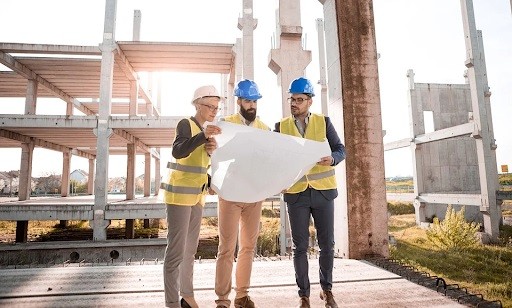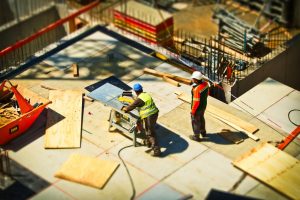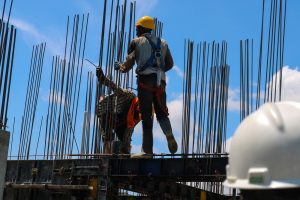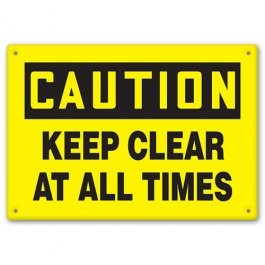Due to the nature of construction work, it can be one of the most dangerous jobs to choose. To help your construction business to succeed, You simply cannot go for the cheap options when it comes to health and safety in this kind of workplace as there can be devastating consequences. There are several preventative measures that should be put in place by employers to ensure maximum safety and security, but the responsibility is also on the workers to carry out safe practices and keep an eye out for any potential risks.
Construction sites can be dangerous places, with various hazards that can cause harm to workers, visitors, and members of the public. Therefore, ensuring safety on a construction site is of utmost importance. In this article, we will discuss some essential steps to ensure safety on a construction site in detail.
- Develop a Safety Plan: Developing a comprehensive safety plan is the first step to ensuring safety on a construction site. A safety plan should identify potential hazards on the construction site, establish safety protocols, provide training for workers, and outline emergency procedures. The safety plan should also be regularly reviewed and updated as needed to ensure it remains relevant and effective.
- Conduct Site Hazard Assessments: A site hazard assessment should be conducted to identify potential hazards and risks on the construction site. This assessment should be carried out before any work commences and should be repeated regularly throughout the project. A hazard assessment should consider all aspects of the site, including the site layout, machinery and equipment, materials, and the work being carried out.
- Implement Safety Measures: Once potential hazards have been identified, appropriate safety measures should be put in place. Safety measures may include:
- Providing personal protective equipment (PPE) such as hard hats, gloves, and safety glasses.
- Ensuring that workers are trained in the correct use of machinery and equipment.
- Implementing safe work practices, such as lockout/tag-out procedures for machinery maintenance.
- Ensuring that scaffolding and ladders are secure and in good condition.
- Establishing safe storage procedures for materials, chemicals, and hazardous substances.
- Providing adequate lighting and ventilation on the construction site.
- Ensuring that workers are not fatigued by implementing work schedules that allow for rest breaks.
- Provide Adequate Training: Workers on a construction site should be adequately trained in all aspects of safety, including the correct use of machinery and equipment, safe work practices, and emergency procedures. Training should be provided regularly, and workers should be encouraged to ask questions and report any safety concerns.
- Promote Communication: Effective communication is essential for ensuring safety on a construction site. Workers should be encouraged to report any safety concerns or incidents immediately. Regular safety meetings should be held to discuss safety concerns and provide updates on the progress of the project.
- Ensure Regulatory Compliance: Construction sites are subject to numerous regulations and guidelines, including Occupational Safety and Health Administration (OSHA) regulations, Environmental Protection Agency (EPA) regulations, and local building codes. Compliance with these regulations is essential for ensuring safety on a construction site. Failure to comply can result in fines and legal action, as well as putting workers and the public at risk.
- Use Technology to Improve Safety: Technology can be used to improve safety on a construction site. For example, drones can be used to survey the site and identify potential hazards. Virtual reality can be used to train workers in a safe environment, allowing them to practice working at heights or in hazardous conditions without the risk of injury.
- Have Emergency Procedures in Place: Despite all the precautions taken, accidents can still happen on a construction site. Therefore, it is essential to have emergency procedures in place. Workers should know how to respond to emergencies, including evacuating the site and providing first aid.
- Encourage a Culture of Safety: Finally, it is essential to create a culture of safety on the construction site. This means promoting a mindset where safety is the top priority and where workers feel comfortable reporting safety concerns or incidents. Encouraging a culture of safety requires leadership from the top, with managers and supervisors setting an example by following safety protocols and promoting safe work practices.
Table of Contents
Training
A construction site is a hazardous environment at the best of times, but when you add a sprinkling of inexperienced employees it can become a whole lot worse. You must have the necessary skills and knowledge to be able to work properly when it comes to operating machinery or building a structure, but without the right training these things simply cannot be fully understood. Many vehicles and tools found within a construction site pose a large threat if used inappropriately, and the safety of every employee can be jeopardized by the mistake of just one of them.
There are training courses available for every single aspect of the construction world, but the most important one to look into if you do not know where to start is machine training. If employees do not know how to safely or efficiently operate machines, they are risking their own life, and the safety of everybody around them. Ensuring the correct procedures with regards to machinery is of high significance as mistakes can be fatal.
Protective Wear

The absence of personal protective equipment (or PPE for short) can make any accidents become catastrophes. It’s an employer’s responsibility to provide workers with the necessary protective equipment, and besides the initial cost of purchase there are zero negatives aspects of making the investment. Hard hats are essentials on any site, as they defend the head against falling objects or debris that might otherwise do some serious damage.
For further defense safety goggles, dust masks and shields for the face may also be worn, especially necessary for metal or wood work as during an average days tasks there might be flying sparks or sawdust which otherwise could do some harm. If the working environment is very noisy, employees must be given the option of hearing protection like earplugs or reinforced earmuffs. Often overlooked as you cannot physical see the threat it poses, spending 5 days a week inside clattering and clanging industrial site will cause terrible problems for hearing if precautionary measures are not put in place.
Chemical Safety

Any accidents involving chemicals really must be avoided at every cost, as the repercussions of these events are catastrophic. Keep track of every single compound used on the site, and whatever risks are associated with them. This way you can plan ahead and put the right system in place to avert any potential crisis situation. This information must then be distributed amongst all employees, along with any training they might need to properly understand the risks involved when working with these materials.
Some chemicals may still be released into the air during certain processes, after which they settle as dust if left undisturbed. However, it’s unlikely this covering will be left to sit for long with the nature of the work being carried out, so dust suppression is vital particularly for any outside work to prevent any possible spread to civilians. All chemical work should be done in the most controlled environment possible, and all employees involved must be aware of the dangers of malpractice.
Communication
The volume inside the average construction business is often head-splitting. This makes it virtually impossible for workers to communicate proficiently, leading to mistakes and unsafe situations. However effective communication is key to the quality completion of any task, especially those involving teamwork, so employees must have the means to get their voices heard. It’s also important for employees on the ground, who are the first to notice any errors or possible warning signs, helping to avert a crisis before it spirals. Workers should be encouraged to blow the whistle on any unsafe practices without negative consequences, as their lives are on the line every day when they come to work.
Machinery Checks And Maintenance
The conditions of any machinery used on a construction site must be well maintained. Noticing an issue only when smoke starts to cloud is a prime example of a terribly unsafe work practice. Regularly checking machines for faults or operating issues is of utmost importance, especially when it comes to vehicles or electric saws and other sharp devices as they can cause the most damage to humans. Most problems they encounter are due to debris or dust getting stuck inside vents or joints, so cleaning them often can help to prevent this.
Professionals can be outsourced to complete this task but its still vital that workers carry out their own basic maintenance of machines in order to understand the engineering and process to a higher level.
 Clear Signage
Clear Signage
Employees are often overloaded with information, which makes it hard to retain absolutely everything. Nevertheless healthy and safety should always be at the forefront of every employees mind during any task they complete, so information and tips for safe practices should be available. Whether this is something as simple as a graphic reminding employees that it’s time to put on their hardhats will help to keep everyone in check. If the worst were to happen, there must be clear signs showing the nearest exits routes. Fire doors must be identifiable, and how to get there must be signaled throughout the building or site.
In an industry so prone to risky situations, it’s important to consider every aspect of health and safety before starting construction each day. It’s the responsibility of everyone on the site to reduce the likelihood of injuries or illness and insecurity amongst employees. By implementing some precautionary measures and ongoing inspections and training, you can ensure that workers are always out of harm’s way.
Construction sites can be some of the most dangerous places to work, and that’s why safety has to be a number one priority at all times. It’s your responsibility as a business owner to keep your employees out of harms way, and there are many different steps that you can follow to ensure they can operate in the safest working environment. So, if you want to learn more about how you can keep your construction staff safe and provide ultimate peace of mind to allow them to work without any worries, then read on to uncover some of the best tips and tricks that you can utilize today.
Personal Protection
Personal protective equipment has to be worn by every member of staff on your construction site, as it’s vital that they are able to keep themselves safe amongst the various dangers and risks that surround them. First off, you should provide your staff with top quality hard hat helmets, high visibility jackets or clothing items, steel toe capped boots, and ear defenders if they are in a loud environment.
You may also need to provide some more specific PPE, such as safety goggles to protect against flying objects during activities like sawing, as well stopping the harmful eye side effects related to regular exposure to sparks. Assess which kinds of tasks get completed and the machinery used to do so to determine any extra protective equipment that you may need to provide, and ask your staff directly to if they feel as though they need anything else to stay safe whilst doing their job.
Safe Environment
The environment in which your staff complete their daily tasks has to be a safe and secure one, and it’s up to you to ensure that you take steps to reduce the common risks associated with construction sites. Always have clear fire exit routes in every location around your premises, and ensure that every member of staff is fully aware of how to get out in the event of an emergency.
Always carry out regular testing on machinery to ensure there are no underlying issues that may put a member of staff at risk, and make use of a crane wind speed meter before operating a crane or other similar vehicle to keep things safe. If your staff are unaware of how to use any machinery properly then they put them self and everyone around them in danger, so it’s absolutely vital that they are able to access any information they need with regards to training and machine operation. It’s a good idea to create a set of house rules that can maintain a safe environment, such as clearing up after yourself whilst keeping walkways free of debris.
With any luck, this guide can help you to understand just how easy it can be to keep your construction workers safe whilst they are on the job. Start off by investing in some high quality personal protection equipment that they can wear to reduce common injury risks, and create a safe environment in which they can thrive.
The construction industry is a precarious one. Due to the very nature of the work, it can be quite dangerous, especially as workers are exposed to numerous malfunctions or risks of falling and this is just the tip of the iceberg. In any industry where machinery is at the forefront, whether it’s a fleet of vehicles or any kind of manual labor, it’s crucial that we learn to look after our workers. But what are the most important ways that you can look after your construction workers?
The Correct Protective Gear
On a very simple level, the protective gear can mean the difference between a minor injury and a major one. Depending on the individual’s role, it’s crucial to provide adequate safety gear for the head and if they are working with open flames it’s crucial to provide flame-resistant materials. There are outlets like https://www.froutlet.com/ which provide a starting point. It’s also important to keep an eye on these items of clothing. If they become unfit for purpose they have to be replaced as soon as possible.
Incorporating Health And Safety Training
It’s not enough to say that your workers should display some common sense; when construction workers are working in various environments there is a high risk associated. Each worker has to be aware of the risks associated with what they do. This is especially true for those that work in confined spaces or with machinery and, of course, if they are working up high. It’s also important to make sure that they are aware of the basic practices of first aid or can administer life-saving techniques.
Regular Inspections

A good construction worker has reliable tools. In any industry regular inspections of equipment and tools are vital. If the tools are broken there’s going to be a higher risk of accidents and in the construction industry, this could mean the big difference between a loss of limb or a loss of life. It’s the responsibility of the employer as well as the worker to make sure there are no issues with any defective equipment. It’s possible to work with specific firms that can provide equipment inspection.
In fact, many suppliers of equipment can provide the inspection which will prove beneficial for a long-term working relationship. A supplier like https://www.sparrowsgroup.com/ provides lifting equipment but also offers the service of inspection. This can help you to save money across the board.
An Open-Door Policy
It’s not just to do with the physical components of the work but it’s also about making sure that you communicate with your staff. In addition to this, it is important that you implement a culture of communication. Employees need to speak to each other if there are any discernible risks or potential hazards. But it’s not enough to ask your employees to mention things if there are any issues but you’ve got to be proactive and ask your employees about what they would think can make their job easier.
The construction industry is one of those industries that is viewed as generally unsafe. While it’s not as bad as it was a few decades ago it’s partly to do with more stringent operational procedures. Make sure that you look after your construction workers.
 It’s no secret that an engaged workforce is vital to the long term success of a business. Motivated, loyal employees can improve every aspect of a company, from its balance sheet to its health and safety record.
It’s no secret that an engaged workforce is vital to the long term success of a business. Motivated, loyal employees can improve every aspect of a company, from its balance sheet to its health and safety record.
Construction companies need to devote time, effort, and resources to measuring and improving employee engagement if they are to reap the benefits.
Over the five years, the construction industry has performed very well in terms of employee engagement, but the very nature of the industry means that this can change very quickly.
Measuring employee engagement
It’s important that employee engagement is measured continually. The days of the annual survey are over, they only provide a snapshot of the company at a given moment. When you finally compile and analyze the data, you could be looking at a very different company.
Your employee engagement strategy should be woven into the very fabric of your company, from the hire strategy to the exit interview.
Due to their dispersed workforces, using an employee engagement platform for continuous listening is a good solution for construction companies.
Ask the right questions
Many people make the mistake of asking the wrong questions in an employee survey. What is the point of asking questions on issues that you cannot change?
It’s not all about work, people are well-rounded individuals who have lives, goals, and issues outside of their job.
Find out if your employees feel that their work impacts their personal lives and what can be done to manage that.
Show strong leadership

Commitment to employee engagement has to come from the top-down, it’s not just an HR initiative. It has to flow through all levels of leadership and management.
Good managers create engaged teams who feel valued and will work more productively and efficiently.
Offer a clear path to progress
Employees who feel like they are stuck in a job with no prospects or career paths are likely to become disengaged very quickly. By having a clear progression through the company, with promotions, increases in responsibility and salary.
Create meaning
People are happy when they believe in what they are doing. Even if a job doesn’t seem overtly meaningful, good leaders will find a way to motivate their team by communicating their importance to the company.
Recognition and reward performance
Being recognized for your work is a great confidence boost. Make sure that achievement is recognized at all levels of your company. It’s not enough to assume that their salary is enough of a motivator. The rewards don’t always have to be financial. If in doubt, ask your employees how they would like to be recognized.
Conclusion
The nature of the construction industry produces its own unique set of challenges when it comes to employee engagement. By implementing continuous listening and devoting resources to making meaningful change, you are more like to achieve the holy grail of employee engagement.
Engaged employees are more productive, happier, take less sick days, and are more willing to go the extra mile for their employers. It can even directly impact the health and safety record of a company.
 Clear Signage
Clear Signage